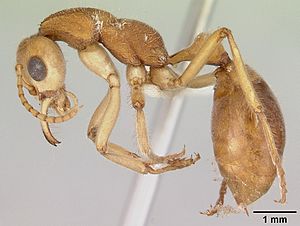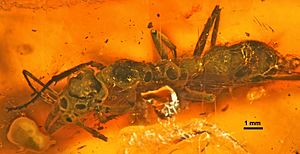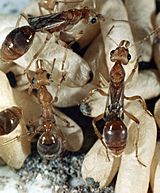Prionomyrmecini facts for kids
Quick facts for kids Prionomyrmecini |
|
|---|---|
 |
|
| Nothomyrmecia macrops | |
| Scientific classification |
|
| Kingdom: | Animalia |
| Phylum: | Arthropoda |
| Class: | Insecta |
| Order: | Hymenoptera |
| Family: | Formicidae |
| Subfamily: | Myrmeciinae |
| Tribe: | Prionomyrmecini Wheeler, 1915 |
| Genera | |
|
|
| Synonyms | |
|
Nothomyrmecii Clark, 1934 |
|
Prionomyrmecini is a special group of ants. It was first named by a scientist named William Morton Wheeler in 1915. This group includes two types of ants: the living Nothomyrmecia and the extinct Prionomyrmex.
Scientists once thought this group was a separate ant family. This was because Nothomyrmecia and Prionomyrmex look very similar. But most scientists now agree they are a "tribe" within the Myrmeciinae ant subfamily. These ants have long, thin bodies. They also have strong stingers and long jaws called mandibles.
Long ago, fossil Prionomyrmecini ants lived all over Europe. They might have lived in trees and liked jungle areas. Today, the only living Prionomyrmecini ants are found in Australia. They prefer old forests with Eucalyptus trees. Nothomyrmecia ants eat nectar and small bugs. They use their big eyes to find food and to navigate. These ants are quite basic in their social life. They do not tell other ants where to find food. Their colonies are small, usually with 50 to 100 ants.
Contents
How Scientists Classified These Ants
Scientists have studied Prionomyrmecini ants for a long time. They wanted to understand where these ants fit in the ant family tree.
Early Discoveries
In 1915, an American scientist named William Morton Wheeler first described the Prionomyrmecini group. He found the extinct ant Prionomyrmex in fossilized tree sap called Baltic amber. He thought it belonged to a different ant family called Ponerinae.
Later, in 1954, another scientist, William Brown Jr., moved the group. He noticed that Prionomyrmex looked a lot like other ants in the Myrmeciinae family. This included Myrmecia and Nothomyrmecia.
Debates and Changes
In 2000, a scientist named Cesare Baroni Urbani found a new fossil species. He named it Prionomyrmex janzeni. After studying it, he thought Nothomyrmecia and Prionomyrmex were so similar they should be considered the same. He even suggested renaming Nothomyrmecia macrops to Prionomyrmex macrops. He also thought the group should be a separate ant family.
However, in 2003, other scientists, Dlussky & Perfilieva, disagreed. They said Nothomyrmecia and Prionomyrmex were different enough. They moved both back into the Myrmeciinae subfamily. They also decided Prionomyrmecini should be a "tribe" again. Most ant scientists today agree with this classification. So, Nothomyrmecia macrops and the extinct Prionomyrmex are the only accepted members of this ant tribe.
What Prionomyrmecini Ants Look Like and Where They Live
Prionomyrmecini ants have some unique features. They have very small or missing simple eyes (ocelli). They also have a special ridge on their face called a clypeal carina.
Physical Features
Prionomyrmex ants are quite large. They have thin bodies, long jaws (mandibles), and strong stingers. They usually measure about 12 to 14 millimeters long. Their body shape suggests they are more "primitive" than some other ants like Myrmecia.
Nothomyrmecia ants are a bit smaller than Prionomyrmex. They are about 9.7 to 11 millimeters long. They also have a long stinger, a thin body, and long mandibles. While Nothomyrmecia and Prionomyrmex look very much alike, you can tell them apart by the shape of a part of their body called the node.
Where They Lived Long Ago
Fossil Prionomyrmecini ants lived in Europe during ancient times, called the Eocene and Late Oligocene periods. Scientists found Prionomyrmex janzeni in Baltic amber from Russia. Another species, Prionomyrmex wappleri, was found in Germany.
The ant Prionomyrmex longiceps was found in Baltic amber from the Eocene. Scientists believe these ants lived in trees. This is because they had long legs, sharp claws, and long mandibles. Prionomyrmex ants likely preferred warm, jungle-like places at lower elevations.
Where They Live Today
Nothomyrmecia ants are now only found in Australia. For a long time, scientists only knew about a few original samples found in Western Australia in 1931. Many scientists, including E. O. Wilson, tried to find them but failed. They worried these ants might be extinct.
But in 1977, scientist Robert W. Taylor rediscovered Nothomyrmecia. He found them in Poochera, South Australia, which was far from where they were first found. These ants live in old mallee woodlands. These areas have many Eucalyptus trees. Only a few small colonies of Nothomyrmecia are known. Because of this, they are listed as Critically Endangered by the International Union for the Conservation of Nature.
Behaviour and Life Cycle
Nothomyrmecia and Prionomyrmex ants act similarly to their relatives in the Myrmeciinae family.
Foraging and Diet
Prionomyrmex ants likely searched for food on the ground or in trees. They probably ate nectar and small bugs. Nothomyrmecia workers drink the blood-like fluid (called hemolymph) from insects they catch. Their young (larvae) eat meat.
We don't know if the extinct ants were active during the day or night. But Nothomyrmecia ants are active at night. They prefer very cold nights for foraging. Both types of ants have large compound eyes. They use their good eyesight to find prey and to navigate.
These ants have a simple social life. Workers do not call others to food sources. They also do not leave scent trails (trail pheromones) for other ants to follow. This means they usually search for food alone. Some Prionomyrmex ants were found to have tiny parasites called stylopids. We don't know what animals prey on these ants.
Reproduction and Colony Life
Nothomyrmecia queens have small, stubby wings. This means they cannot fly. This might be a special way they have adapted to their small colonies. It could also be because of their unique environment.
The winged ants (alates) might appear in late summer or early autumn. Queens that start new colonies dig deep underground. They begin to lay eggs in the spring. Queens produce only one generation of ants each year. It can take 12 months for eggs to fully develop.
When a colony is grown, it usually has only 50 to 100 ants. In some colonies, a new queen can take over if the old queen dies. This new queen is usually one of her daughters. This way of starting a new queen within the same nest might help the colony live on forever.
Images for kids




